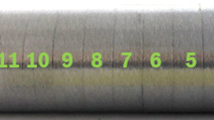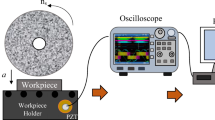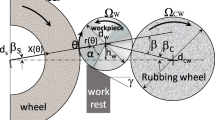Abstract
Grinding burn is a common problem in high-performance industrial manufacturing. Usually destructive (e.g., nital etching) or non-destructive (e.g., Barkhausen noise analysis) methods are used to detect these unwanted changes of the workpiece properties. In recent years, different investigations for the in-process monitoring of grinding burn are conducted in a research environment. One main drawback of most of these detection methods is the lack of robustness and transferability. Therefore, this study provides a new feature-based approach to detect thermal damages in external cylindrical rough grinding using machine learning. To evaluate the robustness properties of the learning algorithm, a large series of experiments is conducted comprising different process parameters and system variables such as workpiece materials, grain sizes and bonding types. Using the burn threshold diagram, a linear separation boundary for parts with and without thermal damage is identified for one process setup. Due to the missing generalization property of the burn threshold analysis, multiple machine learning models are trained and optimized according to three levels of generalization. After achieving an accuracy of more than \(98~\%\) for a constant process setup, the model is expanded to make predictions independently from the values of the system variables showing only a slightly reduced accuracy. In addition, the obtained model is also able to generalize to new values of the system variables by maintaining the high recall of the classification model.















Similar content being viewed by others
References
Klocke F (2017) Fertigungsverfahren 2: Zerspanung mit geometrisch unbestimmter Schneide. Springer, Berlin Heidelberg,. https://doi.org/10.1007/978-3-662-53310-9
Wegener K, Baumgart C (2018) Grinding burn. In: Chatti S, Laperrire L, Reinhart G, Tolio T (eds) CIRP Encyclopedia of Production Engineering, Springer, Berlin Heidelberg, pp 800–806. https://doi.org/10.1007/978-3-642-35950-7
Rowe WB (2014) Principles of Modern Grinding Technology, 2nd edn. William Andrew Publishing, Oxford. https://doi.org/10.1016/B978-0-323-24271-4.00007-5
ISO14104:2017(E) (2017) Gears-surface temper etch inspection after grinding, chemical method. Standard, International Organization for Standardization
Karpuschewski B, Knoche HJ, Hipke M (2008) Gear finishing by abrasive processes. CIRP Ann 57(2):621–640. https://doi.org/10.1016/j.cirp.2008.09.002
Neslušan M, Čížek J, Kolařík K, Minárik P, Čilliková M, Melikhova O (2017) Monitoring of grinding burn via barkhausen noise emission in case-hardened steel in large-bearing production. J Mater Process Technol 240:104–117. https://doi.org/10.1016/j.jmatprotec.2016.09.015
Lanzagorta J, Urgoiti L, Vazquez PR, Barrenetxea D, Sánchez J (2020) Experimental approach for a grinding burn in-process inspection system based on eddy current. Procedia CIRP 87:391–396, 5th CIRP Conference on Surface Integrity (CSI 2020). https://doi.org/10.1016/j.procir.2020.02.011
Yang Z, Wu H, Yu Z, Huang Y (2014) A non-destructive surface burn detection method for ferrous metals based on acoustic emission and ensemble empirical mode decomposition: from laser simulation to grinding process. Meas Sci Technol 25(3):035602
Köhler J (2014) Grinding parameters. In: Laperrière L, Reinhart G (eds) CIRP Encyclopedia of Production Engineering, Springer Berlin Heidelberg, Berlin, Heidelberg, pp 597–601. https://doi.org/10.1007/978-3-642-20617-7_6424
Sauter E, Winter M, Sarikaya E, Wegener K (2021) In-process detection of grinding burn using machine learning. Int J Adv Manuf Tech 115:2281–2297. https://doi.org/10.1007/s00170-021-06896-9
Malkin S (1974) Thermal aspects of grinding: Part 2: Surface temperatures and workpiece burn. J Eng Ind 96(4):1184–1191. https://doi.org/10.1115/1.3438493
Malkin S, Lenz E (1978) Burning limit for surface and cylindrical grinding of steels. Annals of the CIRP 27(1):233–236
Bell A, ** T, Stephenson D (2011) Burn threshold prediction for high efficiency deep grinding. Int J Mach Tools Manuf 51(6):433–438. https://doi.org/10.1016/j.ijmachtools.2011.01.006
Subrahmanya N, Shin YC (2008) Automated Sensor Selection and Fusion for Monitoring and Diagnostics of Plunge Grinding. J Manuf Sci Eng 130(3). https://doi.org/10.1115/1.2927439031014
Vits R (1985) Technologische Aspekte der Kühlschmierung beim Schleifen. PhD thesis, Techn. Hochschule Aachen
Steffan M, Haas F, Pierer A, Gentzen J (2017) Adaptive grinding process (AGriPro) prevention of thermal damage using OPC-UA technique and in-situ metrology. Journal of Manufacturing Science and Engineering 139(12)
Jermolajev S, Epp J, Heinzel C, Brinksmeier E (2016) Material modifications caused by thermal and mechanical load during grinding. In: 3rd CIRP Conference on Surface Integrity, vol 45, pp 43–46. https://doi.org/10.1016/j.procir.2016.02.159
Heinzel C, Heinzel J, Guba N, Hsemann T (2021) Comprehensive analysis of the thermal impact and its depth effect in grinding. CIRP Ann 70(1):289–292. https://doi.org/10.1016/j.cirp.2021.04.010
Eda H, Kishi K, Usiu N, Kakino Y, Fujiwara A (1983) In-process detection of grinding burn by means of utilizing acoustic emission. J Japan Soc Precision Eng 49(9):1257–1262. https://doi.org/10.2493/jjspe1933.49.1257
Wang Z, Willett P, DeAguiar PR, Webster J (2001) Neural network detection of grinding burn from acoustic emission. Int J Mach Tools Manuf 41(2):283–309. https://doi.org/10.1016/S0890-6955(00)00057-2
Kwak JS, Ha MK (2004) Neural network approach for diagnosis of grinding operation by acoustic emission and power signals. J Mater Process Technol 147(1):65–71. https://doi.org/10.1016/j.jmatprotec.2003.11.016
de Aguiar PR, Bianchi EC, Canarim RC (2012) Monitoring of Grinding Burn by Acoustic Emission, 2nd edn, IntechOpen, chap 16, pp 341–364. https://doi.org/10.5772/31339
Távora CG, Aguiar PR, Castro BA, Andreoli AL, Bianchi EC (2021) Hinkley criterion applied to detection and location of burn in grinding process. Int J Adv Manuf Tech 113:3177–3188. https://doi.org/10.1007/s00170-021-06828-7
Griffin JM, Chen X (2009) Multiple classification of the acoustic emission signals extracted during burn and chatter anomalies using genetic programming. Int J Adv Manuf Tech 45(11–12):1152. https://doi.org/10.1007/s00170-009-2026-7
Yang Z, Yu Z (2013) Experimental study of burn classification and prediction using indirect method in surface grinding of AISI 1045 steel. Int J Adv Manuf Tech 68(9):2439–2449. https://doi.org/10.1007/s00170-013-4882-4
Gao Z, Lin J, Wang X, Liao Y (2019) Grinding burn detection based on cross wavelet and wavelet coherence analysis by acoustic emission signal. Chinese J Mech Eng 32(1). https://doi.org/10.1186/s10033-019-0384-0
Guo W, Li B, Shen S, Zhou Q (2019) An intelligent grinding burn detection system based on two-stage feature selection and stacked sparse autoencoder. Int J Adv Manuf Tech 103(5):2837–2847. https://doi.org/10.1007/s00170-019-03748-5
Lajmert P, Sikora M, Kruszynski B, Ostrowski D (2018) Application of principal component analysis and decision trees in diagnostics of cylindrical plunge grinding process. In: Hamrol A, Ciszak O, Legutko S, Jurczyk M (eds) Advances in Manufacturing. Springer International Publishing, Cham, pp 707–716
Gao Z, Wang X, Lin J, Liao Y (2017) Online evaluation of metal burn degrees based on acoustic emission and variational mode decomposition. Measurement 103:302–310. https://doi.org/10.1016/j.measurement.2017.02.049
Mahata S, Shakya P, Babu NR (2021) A robust condition monitoring methodology for grinding wheel wear identification using hilbert huang transform. Precis Eng 70:77–91. https://doi.org/10.1016/j.precisioneng.2021.01.009
Hübner HB, Duarte MAV, da Silva RB (2020) Automatic grinding burn recognition based on time-frequency analysis and convolutional neural networks. Int J Adv Manuf Tech 110(7–8):1833–1849. https://doi.org/10.1007/s00170-020-05902-w
Dotto FRL, Aguiar PRd, Bianchi EC, Serni PJA, Thomazella R (2006) Automatic system for thermal damage detection in manufacturing process with internet monitoring. J Braz Soc Mech Sci Eng 28:153–160. https://doi.org/10.1590/S1678-58782006000200004
Liu Q, Chen X, Gindy N (2005) Fuzzy pattern recognition of ae signals for grinding burn. Int J Mach Tools Manuf 45(7):811–818. https://doi.org/10.1016/j.ijmachtools.2004.11.002
Malkin S, Guo C (2007) Thermal analysis of grinding. CIRP Ann 56(2):760–782. https://doi.org/10.1016/j.cirp.2007.10.005
Rowe W, ** T (2001) Temperatures in high efficiency deep grinding (HEDG). CIRP Ann 50(1):205–208. https://doi.org/10.1016/S0007-8506(07)62105-2
Marinescu ID, Rowe WB, Dimitrov B, Inasaki I (2004) Tribology of abrasive machining processes, 1st edn. William Andrew Publishing
Deutsche Edelstahlwerke GmbH (2011) Datenblatt 1.1191/1.1201. Online, last access 2021-09-07, URL https://www.dew-stahl.com/fileadmin/files/dew-stahl.com/documents/Publikationen/Werkstoffdatenblaetter/Baustahl/1.1191_1.1201_de.pdf
Rowe WB, Black SCE, Mills B (1996) Temperature control in CBN grinding. Int J Adv Manuf Tech 12(6):387–392. https://doi.org/10.1007/BF01186926
** T, Stephenson D (2003) Investigation of the heat partitioning in high efficiency deep grinding. International Journal of Machine Tools and Manufacture 43(11), 1129–1134, DOI: 10.1016/S0890-6955(03)00123-8
Rebala G, Ravi A, Churiwala S (2019) An Introduction to Machine Learning. Springer, Cham,. https://doi.org/10.1007/978-3-030-15729-6
Chen T, Guestrin C (2016) XGBoost: A scalable tree boosting system. CoRR 10(1145/2939672):2939785
Pedregosa F, Varoquaux G, Gramfort A, Michel V, Thirion B, Grisel O, Blondel M, Prettenhofer P, Weiss R, Dubourg V, Vanderplas J, Passos A, Cournapeau D, Brucher M, Perrot M, Duchesnay Édouard (2011) Scikit-learn: Machine learning in python. J Mach Learn Res 12(85):2825–2830
Shahriari B, Swersky K, Wang Z, Adams RP, de Freitas N (2016) Taking the human out of the loop: A review of Bayesian optimization. Proc IEEE 104(1):148–175. https://doi.org/10.1109/JPROC.2015.2494218
Lundberg SM, Erion G, Chen H, DeGrave A, Prutkin JM, Nair B, Katz R, Himmelfarb J, Bansal N, Lee SI (2020) From local explanations to global understanding with explainable AI for trees. Nature Machine Intelligence 2(1)
National Instruments (2019) NIDAQmx for Python. https://nidaqmx-python.readthedocs.io/
Author information
Authors and Affiliations
Corresponding author
Ethics declarations
Competing interests
On parts of this work, a patent was filed.
Additional information
Publisher’s Note
Springer Nature remains neutral with regard to jurisdictional claims in published maps and institutional affiliations.
Rights and permissions
About this article
Cite this article
Sauter, E., Winter, M. & Wegener, K. Analysis of robustness and transferability in feature-based grinding burn detection. Int J Adv Manuf Technol 120, 2587–2602 (2022). https://doi.org/10.1007/s00170-022-08834-9
Received:
Accepted:
Published:
Issue Date:
DOI: https://doi.org/10.1007/s00170-022-08834-9




